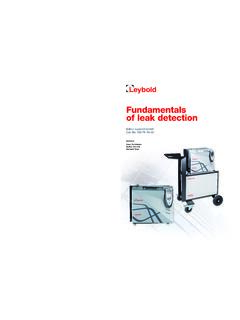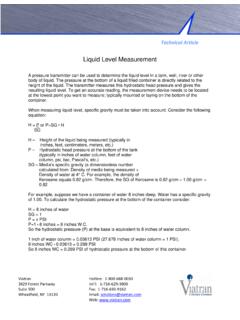Transcription of CHAPTER 8: Thermal Infrared Remote Sensing
1 1 CHAPTER 8 CHAPTER 8 CHAPTER 8: CHAPTER 8: Thermal InfraredThermal InfraredRemote SensingRemote SensingggREFERENCE: Remote Sensing REFERENCE: Remote Sensing of the Environment of the Environment John R. Jensen (2007)John R. Jensen (2007)Second EditionSecond EditionPearson Prentice HallPearson Prentice Hall2 Thermal Infrared Remote SensingThermal Infrared Remote SensingThermal Infrared energyis emitted from all objectsthat have a temperature greater than absolute , all the features we encounter in the landscape on atypical day (Sun, vegetation, soil, rocks, water, and evenpeople) emit Thermal Infrared electromagnetic eyes cannot detect differences in Thermal infraredenergybecausetheyareprimarilysen sitivetovisiblelightenergybecausetheyare primarilysensitivetovisiblelightfrom 400 to 700 nm.
2 Our eyes are not sensitive to thereflective Infrared (700 nm - m) or Thermal infraredenergy ( - 14 m). The astronomer Sir Frederick William Herschel (1738-1822) discovered the Infrared portion of the electromagnetic spectrum in History of Thermal Infrared Remote Sensing1800 described in his famous paper Investigations of the Powers of the Prismatic Colours to Heat and Illuminate Objects: with Remarks. In 1879, S. P. Langley began a research program to find a superior radiation detector. One year later he invented the bolometer that was able to obtain measurable temperature variations of 1/10,000 C. p In World War I, S. O. Hoffman could detect men at 120 m and eventually aircraft.
3 In the 1930s, Germany developed the Kiel system for discriminating between bombers and night fighters. 3 History of Thermal Infrared Remote Sensing The single most important development in Infrared technology was the development of the detector element by nations at war during World War II. Early Infrared detectors were lead salt photodetectors. Now we have very fast detectors consisting of mercury-doped germanium (Ge:Hg), indium antimonide (InSb) and other substances that are very responsive to Infrared radiation. We also have computers to rapidly process and display the Thermal radiometric measurements. In 1968, the government declassified Thermal Infrared Remote Sensing systems that did not exceed a certain spatial resolution and temperature sensitivity.
4 The first declassified satellite Remote sensor data were collected by the U. S. Television IR Operational Satellite (TIROS) launchedHistory of Thermal Infrared Remote Sensingby the U. S. Television IR Operational Satellite (TIROS) launched in 1960. The coarse resolution Thermal Infrared data were ideal for monitoring regional cloud patterns and frontal movement. NASA launched the Heat Capacity Mapping Mission (HCMM) on April 26, 1978 that obtained 600 x 600 m spatial resolution Thermal Infrared data ( - m) both day (1:30 pm) and night (2:30 am) This was one of the first scientifically orientednight (2:30 am). This was one of the first scientifically oriented (geology) Thermal Infrared systems.
5 NASA s Nimbus 7 launched on October 23, 1978 had a Coastal Zone Color Scanner (CZCS) that included a Thermal Infrared sensor for monitoring sea-surface temperature. 4 In 1980, NASA and the Jet Propulsion Laboratory developed the thl i fdltit l(TIMS) th tiHistory of Thermal Infrared Remote Sensingthermal Infrared multispectral scanner (TIMS) that acquires Thermal Infrared energy in six bands at wavelength intervals of < m. Successful studies using TIMS resulted in the development of the 15-channel Airborne Terrestrial Applications Sensor (ATLAS). Landsat Thematic Mapper 4 and 5 sensors were launched on July 16, 1982 and March 1, 1984, respectively, and collected 120 x 120 m Thermal Infrared data ( - m) along with two bands of middle Infrared data.
6 Today, the NOAA Geostationary Operational Environmental Satellite (GOES) collects Thermal infraredHistory of Thermal Infrared Remote SensingEnvironmental Satellite (GOES) collects Thermal Infrared data at a spatial resolution of 8 x 8 km for weather prediction. Full-disk images of the earth are obtained every 30 minutes both day and night by the Thermal Infrared sensor. The NOAA Advanced Very High Resolution Radiometer The NOAA Advanced Very High Resolution Radiometer (AVHRR) collects Thermal Infrared local area coverage (LAC) data at x km and global area coverage (GAC) at 4 x 4 km. The routine collection of Thermal Infrared data are a part of each person s daily life as we watch the nightly weather report.
7 5 Characteristics Characteristics of a Thermal of a Thermal Infrared Infrared Airborne Airborne amplifier high-density magnetic tape hot libi optional film recorder focusing mirrors dewar of liquid nitrogen detector recorder mirror modulated light source motorscan mirrorAcrossAcross--track track ScannerScannerH calibration source cold source radiant flux, within the instantaneous-field-of-view, total angular field-of-view D Thermal Infrared Image of Effluent Entering the Savannah River Swamp System6 Kinetic Heat, Temperature, Kinetic Heat, Temperature, Radiant Energy and Radiant FluxRadiant Energy and Radiant Flux The energy of particles of matter in random motion is called kinetic heat (also referred to as internal real or true heat) Allkinetic heat (also referred to as internal, real, or true heat).
8 All objects having a temperature above absolute zero (0 K; C; and F) exhibit this random motion. When these particles collide they change their energy state and emit electromagnetic radiation. The amount of heat can be measured in calories (the amount of htidt i thttf1 f t 1 C) Wheat required to raise the temperature of 1 g of water 1 C). We can measure the true kinetic temperature (Tkin) or concentration of this heat using a thermometer. We perform this in situ temperature measurement when we are ill. We can also measure the true kinetic internal temperature of soil or water by physically touching them with a thermometer. Fortunately for us, an object s internal kinetic heat is also converted to radiant energy (often called external or apparent Kinetic Heat, Temperature, Kinetic Heat, Temperature, Radiant Energy and Radiant FluxRadiant Energy and Radiant Fluxgy (ppenergy).
9 The electromagnetic radiation exiting an object is called radiant flux( ) and is measured in watts. The concentration of the amount of radiant flux exiting (emittedfrom) an object is its radiant temperature (Trad). There is usually a high positive correlation between the true kinetic temperature of an object (Tki) and the amount of radiantkinetic temperature of an object (Tkin) and the amount of radiant flux radiated from the object (Trad). Therefore, we can utilize radiometers placed some distance from the object to measure its radiant temperature which hopefully correlates well with the object s true kinetic temperature. Thisis the basis of Thermal Infrared Remote Sensing . 7 Kinetic Heat, Temperature, Kinetic Heat, Temperature, Radiant Energy and Radiant FluxRadiant Energy and Radiant FluxUnfortunately, the relationship is not perfect, with the Remote measurement of the radiant temperature always being slightly less than the true kinetic temperature of the object.
10 This is due to a Thermal property called yyMethods of Heat TransferMethods of Heat TransferPan Conductionin contact with burnera. Conductionoccurs when one body (molecule or atom) transfers its kinetic energy to another by colliding with it. This is how a pan is heated on a stove. 8 Methods of Heat TransferMethods of Heat TransferConvectionTerrainPulse of warm airb. In convection, the kinetic energy of bodies is transferred from one place to another by physically moving the bodies. An example is the convectional heating of air in the atmosphere in the early afternoon. Methods of Heat Transfer Radiationc. EarthSunElectromagnetic waveThe transfer of energy by electromagnetic radiationis of primary interest to Remote radiationis of primary interest to Remote Sensing because it is the only form of energy transfer that can take place in a vacuum such as the region between the Sun and the Windows in the Atmospheric Windows in the Electromagnetic SpectrumElectromagnetic SpectrumThermal Radiation LawsThermal Radiation Laws A blackbodyis a theoretical construct that absorbs all the radiant energy striking it and radiates energy at the maximum possible rate per unit area at each wavelength for any given temperature.






